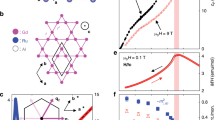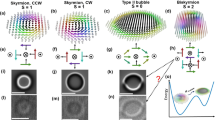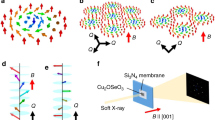Abstract
Skyrmions, topologically protected nanometric spin vortices, are being investigated extensively in various magnets1,2,3,4,5,6,7,8,9,10,11. Among them, many structurally chiral cubic magnets host the triangular-lattice skyrmion crystal (SkX) as the thermodynamic equilibrium state. However, this state exists only in a narrow temperature and magnetic-field region just below the magnetic transition temperature Tc, while a helical or conical magnetic state prevails at lower temperatures. Here we describe that for a room-temperature skyrmion material12, β-Mn-type Co8Zn8Mn4, a field-cooling via the equilibrium SkX state can suppress the transition to the helical or conical state, instead realizing robust metastable SkX states that survive over a very wide temperature and magnetic-field region. Furthermore, the lattice form of the metastable SkX is found to undergo reversible transitions between a conventional triangular lattice and a novel square lattice upon varying the temperature and magnetic field. These findings exemplify the topological robustness of the once-created skyrmions, and establish metastable skyrmion phases as a fertile ground for technological applications.
This is a preview of subscription content, access via your institution
Access options
Subscribe to this journal
Receive 12 print issues and online access
$259.00 per year
only $21.58 per issue
Buy this article
- Purchase on Springer Link
- Instant access to full article PDF
Prices may be subject to local taxes which are calculated during checkout




Similar content being viewed by others
References
Bogdanov, A. N. & Yablonskii, D. A. Thermodynamically stable “vortices” in magnetically ordered crystals. The mixed state of magnets. Sov. Phys. JETP 68, 101–103 (1989).
Mühlbauer, S. et al. Skyrmion lattice in a chiral magnet. Science 323, 915–919 (2009).
Yu, X. Z. et al. Real-space observation of a two-dimensional skyrmion crystal. Nature 465, 901–904 (2010).
Yu, X. Z. et al. Near room-temperature formation of a skyrmion crystal in thin-films of the helimagnet FeGe. Nat. Mater. 10, 106–109 (2011).
Nagaosa, N. & Tokura, Y. Topological properties and dynamics of magnetic skyrmions. Nat. Nanotech. 8, 899–911 (2013).
Heinze, S. et al. Spontaneous atomic-scale magnetic skyrmion lattice in two dimensions. Nat. Phys. 7, 713–718 (2011).
Romming, N. et al. Writing and deleting single magnetic skyrmions. Science 341, 636–639 (2013).
Seki, S., Yu, X. Z., Ishiwata, S. & Tokura, Y. Observation of skyrmions in a multiferroic material. Science 336, 198–201 (2012).
White, J. S. et al. Electric-field-induced skyrmion distortion and giant lattice rotation in the magnetoelectric insulator Cu2OSeO3 . Phys. Rev. Lett. 113, 107203 (2014).
Ishiwata, S. et al. Versatile helimagnetic phases under magnetic fields in cubic perovskite SrFeO3 . Phys. Rev. B 84, 054427 (2011).
Kézsmárki, I. et al. Néel-type skyrmion lattice with confined orientation in the polar magnetic semiconductor GaV4S8 . Nat. Mater. 14, 1116–1122 (2015).
Tokunaga, Y. et al. A new class of chiral materials hosting magnetic skyrmions beyond room temperature. Nat. Commun. 6, 7638–7644 (2015).
Nagaosa, N. & Tokura, Y. Emergent electromagnetism in solids. Phys. Scr. T146, 014020 (2012).
Tokura, Y., Seki, S. & Nagaosa, N. Multiferroics of spin origin. Rep. Prog. Phys. 77, 076501 (2014).
Jonietz, F. et al. Spin transfer torques in MnSi at ultralow current densities. Science 330, 1648–1651 (2010).
Schulz, T. et al. Emergent electrodynamics of skyrmions in a chiral magnet. Nat. Phys. 8, 301–304 (2012).
Yu, X. Z. et al. Skyrmion flow near room temperature in ultra-low current density. Nat. Commun. 3, 988 (2012).
Iwasaki, J., Mochizuki, M. & Nagaosa, N. Current-induced skyrmion dynamics in constricted geometries. Nat. Nanotech. 8, 742–747 (2013).
Sampaio, J., Cros, V., Rohart, S., Thiaville, A. & Fert, A. Nucleation, stability and current-induced motion of isolated magnetic skyrmions in nanostructures. Nat. Nanotech. 8, 839–844 (2013).
Hori, T., Shiraish, H. & Ishii, Y. Magnetic properties of β-CoZnMn alloys. J. Magn. Magn. Mater. 310, 1820–1822 (2007).
Oike, H. et al. Interplay between topological and thermodynamic stability in a metastable magnetic skyrmion lattice. Nat. Phys. 12, 62–67 (2016).
Ritz, R. et al. Giant generic topological Hall resistivity of MnSi under pressure. Phys. Rev. B 87, 134424 (2013).
Kagawa, F. & Oike, H. Quenching of charge and spin degrees of freedom in condensed matter. Adv. Mater. http://dx.doi.org/10.1002/adma.201601979 (2016).
Grüner, G. The dynamics of charge-density waves. Rev. Mod. Phys. 60, 1129–1181 (1988).
Münzer, W. et al. Skyrmion lattice in the doped semiconductor Fe1−xCoxSi. Phys. Rev. B 81, 041203(R) (2010).
Milde, P. et al. Unwinding of a skyrmion lattice by magnetic monopoles. Science 340, 1076–1080 (2013).
Gilardi, R. et al. Direct evidence for an intrinsic square vortex lattice in the overdoped high-T c superconductor La1.83Sr0.17CuO4+δ . Phys. Rev. Lett. 88, 217003 (2002).
Bianchi, A. D. et al. Superconducting vortices in CeCoIn5: toward the Pauli-limiting field. Science 319, 177–180 (2008).
Yi, S. D., Onoda, S., Nagaosa, N. & Han, J. H. Skyrmions and anomalous Hall effect in a Dzyaloshinskii–Moriya spiral magnet. Phys. Rev. B 80, 054416 (2009).
Park, J.-H. & Han, J. H. Zero-temperature phases for chiral magnets in three dimensions. Phys. Rev. B 83, 184406 (2011).
Lin, S.-Z., Saxena, A. & Batista, C. D. Skyrmion fractionalization and merons in chiral magnets with easy-plane anisotropy. Phys. Rev. B 91, 224407 (2015).
Acknowledgements
We are grateful to N. Nagaosa, W. Koshibae, S. Zhang, X. Z. Yu, D. Morikawa, T. Nakajima and N. Kanazawa for fruitful discussions and thank D. Lançon for experimental support at ILL. This work was supported by JSPS Grant-in-Aids for Scientific Research (S) No. 24224009, the Swiss National Science Foundation projects 153451 and 166298, and the European Research Council project CONQUEST.
Author information
Authors and Affiliations
Contributions
Y.Taguchi, H.M.R. and Y.Tokura jointly conceived the project. The sample preparation was performed by K.K., A.K. and Y.Tokunaga. Neutron diffraction measurements of the nuclear peaks were carried out by J.S.W. A.c. magnetic susceptibility measurements were carried out by K.K., H.O. and F.K. Small-angle neutron scattering measurements were carried out by J.S.W., K.K., N.R. and J.L.G. The results were discussed and interpreted by all the authors.
Corresponding author
Ethics declarations
Competing interests
The authors declare no competing financial interests.
Supplementary information
Supplementary Information
Supplementary Information (PDF 1057 kb)
Rights and permissions
About this article
Cite this article
Karube, K., White, J., Reynolds, N. et al. Robust metastable skyrmions and their triangular–square lattice structural transition in a high-temperature chiral magnet. Nature Mater 15, 1237–1242 (2016). https://doi.org/10.1038/nmat4752
Received:
Accepted:
Published:
Issue Date:
DOI: https://doi.org/10.1038/nmat4752
This article is cited by
-
Transition between distinct hybrid skyrmion textures through their hexagonal-to-square crystal transformation in a polar magnet
Nature Communications (2023)
-
Progress on elliptical magnetic skyrmions
Rare Metals (2023)
-
Direct Visualisation of Skyrmion Lattice Defect Alignment at Grain Boundaries
Nanoscale Research Letters (2022)
-
Toggle-like current-induced Bloch point dynamics of 3D skyrmion strings in a room temperature nanowire
Nature Communications (2022)
-
Electric field manipulation of magnetic skyrmions
Rare Metals (2022)



